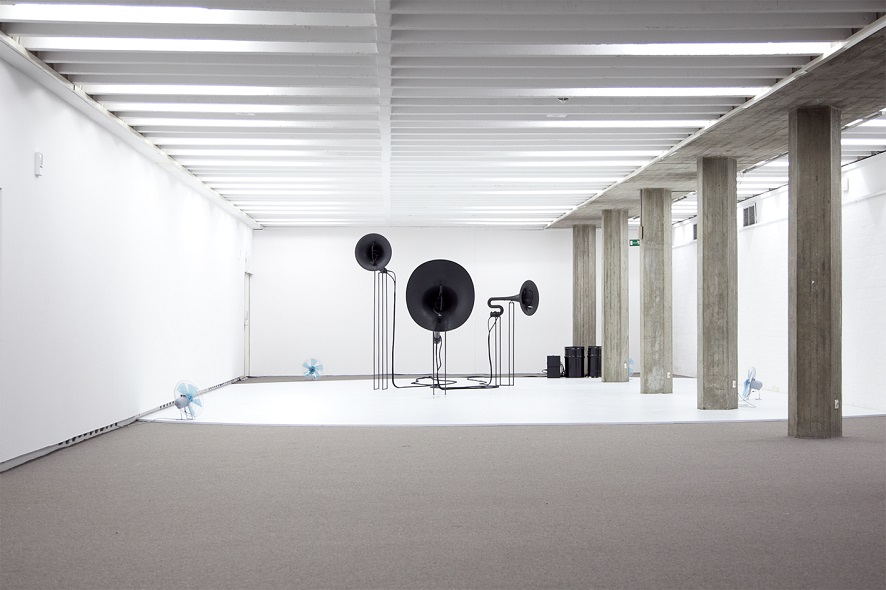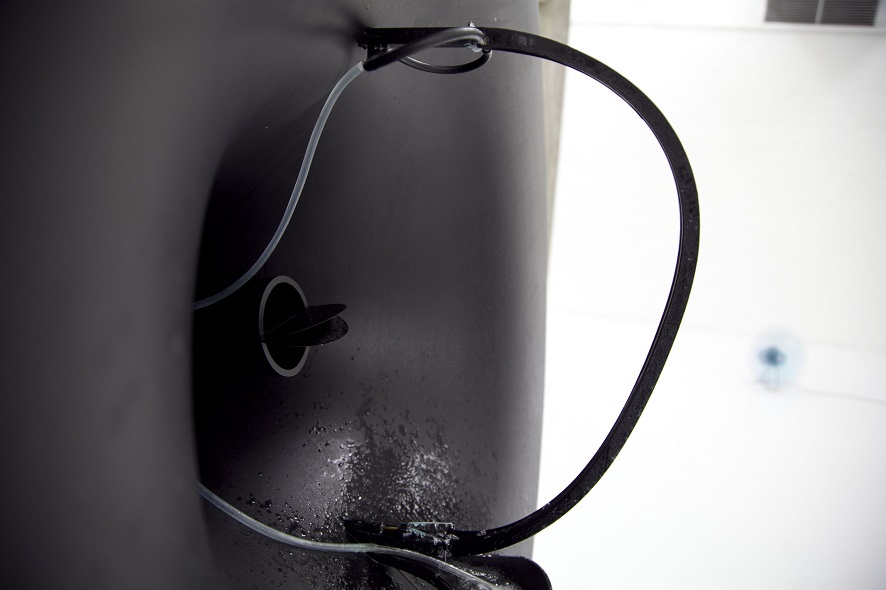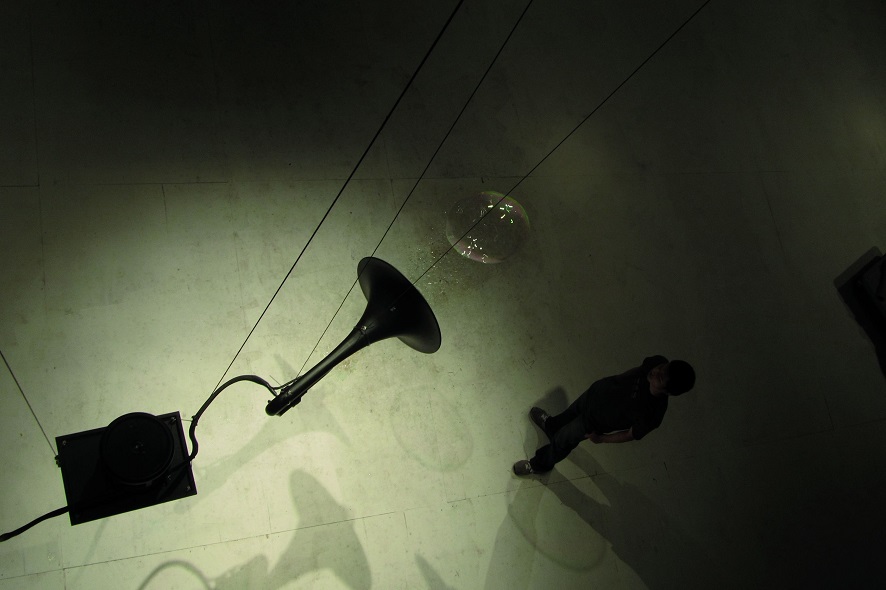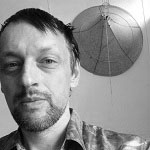Huge black horns use compressed air to produce deep sounds that collide with fine membranes out of soapy water. The sound waves turn into big bubbles that slowly float through space until they burst. Thom Kubli’s installation is definitely one of the don’t-miss highlights at this year’s Ars Electronica Festival September 8-12. The theme is RADICAL ATOMS – and the alchemists of our time.
Here, Thom Kubli explains how he came up with the idea for “Black Hole Horizon,” what challenges he faced executing his concept, and what its title actually means.
How did the idea of “Black Hole Horizon” come to you?
Thom Kubli: A horn that emits soap bubbles as it plays notes is actually a simple image. At the same time, there’s something childlike and unreal about it—a fantastic potential. It intrigued me to find out if it’s technically feasible to turn this idea into a physical reality. The point of “Black Hole Horizon” is to transform sound into a three-dimensional object that can change the space by dint of its presence. Since giant soap bubbles constitute phenomena that are as fantastic as they are fleeting, and each one is totally unique, the space is being repeatedly redefined. Thus, installation visitors are called upon to position their bodies in accordance with the resulting volumes.
It was important to me for the sound to have a material correspondence, not a virtual one. For a very long time, I’ve been coming to terms with translating sound into physical material—for instance, into biomass, a liquid or granulate. This type of transformation touched me in a very special way. It created a very direct aesthetic connection.

Credit: Klaus Fritze
Could you tell us a little bit more about the development process—the choice of the horn’s shape, the technical demands and challenges?
Thom Kubli: Once the idea was formulated in general terms, it quickly became clear that I would need knowledge from a wide range of fields. And indeed, I was soon involved in fluid dynamics, acoustics and musical instrument construction. Since the horn was a kind of invention, there were, of course, no models as far as form and materials are concerned. But I was lucky to get in contact with David Jaschik, who had worked in mechatronics, and Zackery Belanger, who was employed as a physicist and acoustician at EMPAC in New York.
Using self-constructed models and improvised test arrangements, we attempted to find out how the interconnections among the various levels behaved and how we could get the whole thing into synch. There were some pretty far-out constructions along the way. But basically it became clear that we could eventually have a horn that operated with compressed air. And that there had to be fluid circulation. And a device that turned the fluid into a sort of fine membrane out of which the sound modulated the soap bubble.
The objects we finally designed were produced in New York at EMPAC. There, we established the connection to the Architecture Department at Rensselaer Polytechnic Institute, where we had access to 3-D programs to design the horns and could experiment with various materials. Basically, our task was to find out which forms I can freely design with my material and what are forced moves necessitated by the technical constraints. For example, a horn’s pitch is defined by the length of the tubing; other parts of the object, conversely, can be designed more on the basis of visual criteria.

Credit: Thom Kubli
Thematically, “Black Hole Horizon” is a very complex work. It has to do with, among other things, black holes, human consciousness, gravity, as well as spectacle and play. What’s the connection among these thematic elements? Why did you choose them?
Thom Kubli: Naturally, as an artist, I’m interested in human consciousness, since, after all, it’s in direct contact with aesthetic experience. So, how is my consciousness influenced? How are we conditioned—for instance, by play or social spectacle? But also via circumstances that we take so totally for granted that we don’t even perceive them as such—for example, that this planet attracts us with a not inconsiderable force of gravity.
Bringing together themes that don’t apparently belong together—thus, actually incoherent levels—harbors considerable potential. I believe that creatively coming to terms with incoherence is what brings forth the possibility of a radical new aesthetic—confronting things that don’t belong together, allowing them to reciprocally modulate and influence each other, and observing the dynamics at work at boundaries and zones at the fringe of incoherent levels.
I mean, the point is to redefine—or even totally replace—the well-trodden paths of logical relationships with the immediacy of aesthetic experience. And, in the interplay with science, that is simply the task of art.

Credit: Thom Kubli
What’s the significance of the title “Black Hole Horizon” in connection with the work itself?
Thom Kubli: In astrophysics, there’s the term “event horizon” that describes a particular space-time phenomenon. In simple term: when the attractive force of the dark matter of black holes is strong enough, it can even bend a ray of light to such an extent that it’s no longer visible. The boundary of this area is the event horizon. Behind it, there are still stars emitting immense radiation, but due to the gravitational force of dark matter, they can’t be perceived visually. They exist; we just don’t see them. This is not only a fantastic cosmological phenomenon; it’s also a great literary image. Thus, which forces permit what kind of perception in the dynamics of incessant becoming?
In the depiction of sound in terms of material, there’s also this element of alternative perception. Basically, however, this moment also always expresses the sheer possibility of this otherness. That’s why these experiments always evoke such an enigmatic fascination within me.

Credit: Thom Kubli
This year’s festival theme is RADICAL ATOMS – and the alchemists of our time. How is your work related to this theme?
Thom Kubli: “Radical atoms” describes atoms or molecules with “unpaired” electrons. This species is especially reactive, unstable and transformable. Thus, in the sense of artistic work, it has the capacity to trigger unforeseeable processes. This means of developing risky new ideas, the methods and efficiency of which are untested, could, to a considerable extent, determine the future. This is so because they promise creativity and efficiency, even in consideration of the very high complexity of what is required. “Black Hole Horizon” came about in this spirit—an idea whose realization called for quick interaction among many and varied areas of knowledge and levels of work. But the name “Black Hole Horizon” also describes the process of origination with respect to its unpredictability—no soap bubble that comes about is identical to another. It’s unstable; it’s presence is transient. And the path that it takes through the installation space—as a function of the thermal forces at work in it—is unpredictable. In this sense, every soap bubble that emerges is a risky new idea.
“Black Hole Horizon” by Thom Kubli will be featured in the “Alchemists of our Time” exhibition at POSTCITY throughout the Ars Electronica Festival. The exhibition is open Thursday to Monday, September 8-15, 2016 from 10 AM to 7:30 PM.
To find out more about the festival, follow us on Facebook, Twitter, Instagram & Co., subscribe to our Newsletter and check us out online at ars.electronica.art/radicalatoms.

Thom Kubli (CH/DE) is an artist and composer in Berlin. His sound installations have run at the New Museum of Contemporary Art (New York), the Transmediale (Berlin), Ars Electronica (Linz), Laboratorio Arte Alameda (Mexico City), Eyebeam (New York), EMPAC (EMPAC), the Akademie der Künste (Berlin) and at many other museums and galleries. In conjunction with his work, he’s been involved in many international collaborative undertakings with scientific institutions in the fields of computer science, materials science, biotechnology, architecture and psychiatry. His compositional pieces and experimental radio shows have been broadcast by many European stations including WDR, DLRK, DLF and the ORF–Austrian Broadcasting Company.
